Faq
How much do classes cost?
Is this suitable for women?
How different is Shorinji Kempo from other styles such as Karate and Aikido?
Why is this style so obscure compared to Karate and Aikido?
Do you have competitions?
Why are there only 3 color belts?
Are these techniques painful?
Do I need to be in good physical condition to do this?
What is the hand greeting gesture you are using?
Why do you meditate?
What are the words that students recite each class?
How much do classes cost?
All pricing information can be found in the Class Info section of our website. Please email us for more information.
Is this suitable for women?
Absolutely. The techniques of Shorinji Kempo are designed for self-defense. Strength and size are not determinants in skill, as every student learns to adjust techniques to suit their own body. Shorinji Kempo has many female students and instructors. Our branch has numerous talented and committed women who range in skill from white to black belt.
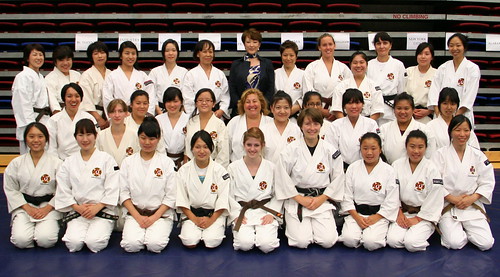
Women Kenshi with President So Yuki
How different is Shorinji Kempo from other styles such as Karate and Aikido?
Shorinji Kempo is a unique system that draws on several different martial arts traditions but is itself original. The only way to really understand this is to experience it for yourself. We do recommend that you visit and observe a class and see for yourself. All visitors are welcome. You may want to go to our Techniques page to see samples of our style. Shorinji Kempo is a licensed international trademark. All branches and instructors are strictly regulated by WSKO.
Why is this style so obscure compared to Karate and Aikido?
Because Shorinji Kempo is a non-commercial and non-profit organization, Shorinji Kempo tends be lesser known especially in the U.S., although it is widespread in Europe and Asia. Monthly tuition goes toward the renting of space, supplies, and the running and maintenance of the class. Shorinji Kempo instructors teach strictly on a volunteer basis and do not get paid. Despite the lack of commercialism, it is very impressive to consider that there are currently over a million Shorinji Kempo students and it is practiced in 33 countries worldwide.
Do you have competitions?
Shorinji Kempo is not about free-fighting competitions or winning contests. Instead there are Taikai events that are a combination of a demonstration show and tournament where students also have a chance to meet each other, sometimes on an international level. Embu in which two kenshi (or more) script together an entire fighting sequence is a main part of Taikai events (another part is randori or unyo-ho, a test of self-defense techniques). Contestants for embu are judged by how well they work together, the precision of their movements and the overall balance of the sequence. In all Embu there can never be a clear winner or loser and despite how simplistic that may sound, it is incredibly challenging. For further information about Taikai, see a report of the 2nd N. American Shorinji Kempo Taikai held in New York City.
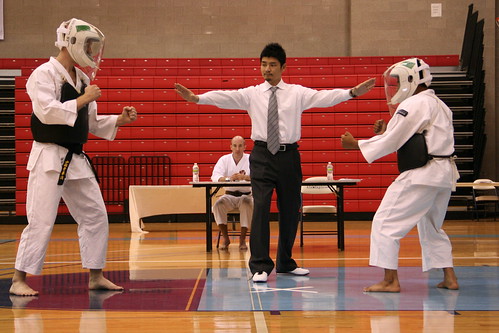
Taikai Randori (sparring)
Why are there only 3 color belts?
Shorinji Kempo uses white, brown and black color belts to designate rank. Within the brown belt category, there are 6 degrees (kyu) whereas in black, there are 10 degrees (dan). Having only 3 colors increases the level of equality among all practitioners.
Are these techniques painful?
Shorinji Kempo is a martial art and as such the techniques have the potential to be very painful. However, one of the key characteristics of Shorinji Kempo is that it should develop people without injury - that is to say the techniques are not designed to cause permanent injury and are practiced in a very controlled way.
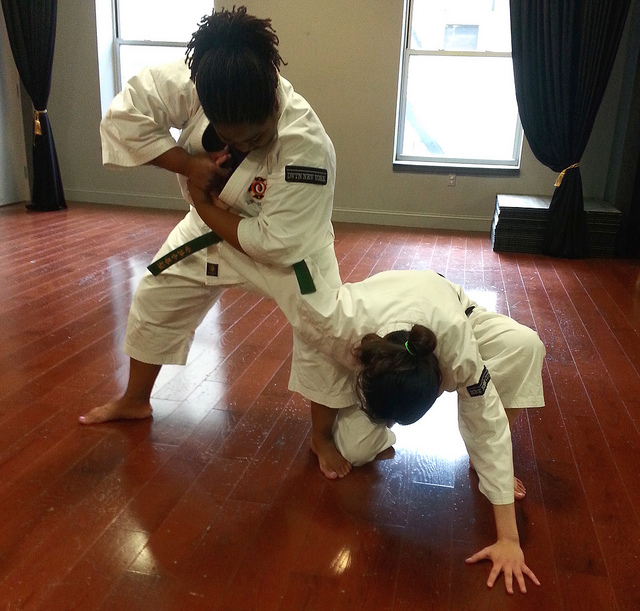
Okuri Maki Tembin (locking technique)
Do I need to be in good physical condition to do this?
One of the key characteristics of Shorinji Kempo is that we all train to our own level of ability. Obviously the more one regularly trains, the more fit, slimmer and flexible one becomes.
What is the hand greeting gesture you are using?
It is called Gassho Rei (shown below) and is taken directly from the Indian (Buddhist) style of greeting. In most Japanese martial arts, students bow to each other. Shorinji Kempo uses Gassho Rei as a form of greeting and it is a symbolic way to show mutual respect.
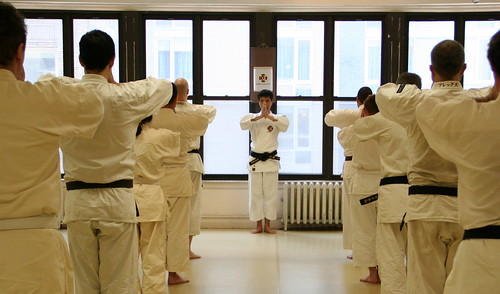
Gassho Rei
Why do you meditate?
Meditation (Chinkon-gyo) is one of the disciplines used to attain clarity and calmness. Shorinji Kempo also uses other methods, such as physical training (Ekkin-gyo) and the study of philosophy. On a practical level, meditation teaches correct breathing and posture, and is an invaluable tool for refreshing the body and mind.
What are the words that students recite each class?
This is the Dokun, our basic statement of principles regarding first ourselves, then our training partners and finally the wider society and the world in general. The three sections distill the core points of our philosophy into short statements that we try to live up to in our training and our everyday lives.
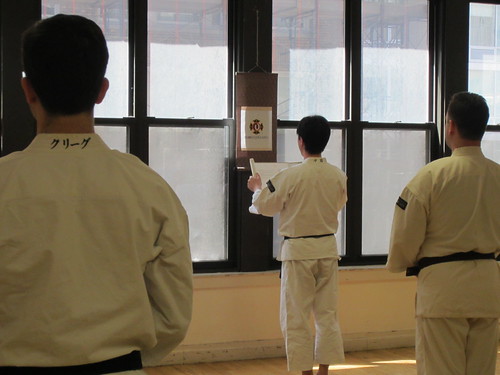
Reading the Dokun
